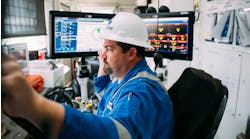HSE software designed to prevent workplace injuries
By Michael Maltsev and Danny Lazourievsky, RigER
HSE management is a critical component of the offshore oilfield industry, regardless of the size or nature of the operations. In the high-stakes environment of offshore drilling and production, prioritizing the well-being of personnel goes beyond regulatory compliance—it is a strategic imperative. Offshore operations are inherently high-risk due to remote locations, harsh weather conditions and complex logistics. Organizations that foster a culture of safety and continuous improvement not only protect their workers and the environment but also gain a competitive edge in operational efficiency and innovation.
In offshore oil and gas, safety is paramount to safeguard workers, prevent environmental disasters, and meet stringent regulatory and customer requirements. The benefits of a robust HSE management system extend to every aspect of offshore operations. Streamlined reporting processes and seamless integration with other business systems ensure compliance with offshore-specific regulations and accurate safety data recording. This comprehensive approach mitigates risks, fosters a culture of safety and ultimately enhances the performance and success of offshore operations.
HSE system
Hours and days after the incident, the information about root cause and details of the incident begin to fade from the memory. It is imperative to have a system in place to timely and accurately capture those details. A standardized system, like the following, will accelerate cross regional and departmental training to facilitate data gathering and reporting of workplace incidents:
- Capture the incident information and details;
- Investigate the incident to determine direct and root causes;
- Assign corrective actions and track their completion;
- Analyze affected cost; and
- Verify the investigation results and conclude the incident report.
Outcome of enhanced HSE monitoring
The systematic approach gives the ability to identify clusters of similar type incidents to highlight any recurring issues. In a case study, a client was able capture incident information as well as identify and resolve the recurring incidents to improve workplace health and safety.
Reporting functions in the specialty software, like the RigER HSE module, help sort the information by incident type, root cause, direct cause, location and other attributes. The client in the case study was able to identify recurring incident types and examine the troublesome location. Corrective actions were taken to enhance training for the line of business at that location and supply the workforce with additional PPE gear that was not part of the base package to mitigate the hazards in the environment.
The HSE module in RigER is managed by the HSE department and access is strictly assigned and controlled to safeguard the data, protect employee confidentiality and conform to OSHA standards.
During the initialization of the incident report, the originator will record attributes such as date, time, location, employee name and incident description. This information will be referenced by the investigator in the next step as they conduct a thorough review of direct and root causes. The investigation is completed, and the corrective actions are assigned. The incident report narrative and synopsis can be shared by the HSE administrator to the management or customer teams through external print forms and stored with limited access in the RigER database.
The final step is generating and analyzing the reports by selecting the incident type, cause, date as an example and sorting by the facility to identify recurring incidents.
Digital oilfield case study
RigER assisted a Louisiana-based oilfield engineering and service company that provides drilling, completions and fracturing services. The company operates multiple lines of business across many departments. Thus, central control and reporting is key to communicating, tracking, reporting and mitigating workplace incidents.
Rental and services dispatch is tied to asset tracking, and equipment is sent and received from offshore platforms and requires rigorous inspections, maintenance, certification and repairs. The company used RigER technology to track each step of the process while operating heavy equipment and machinery to repair and ship equipment to its client. The employee footprint spans across many lines of business, which presents a variety of safety hazards from shop floor operations to transportation and delivery of large equipment. HSE policies were set in place, and RigER technology was used to record, investigate and resolve those incidents. The HSE module allowed users to see trends through reporting and address incidents with high occurrence rates by addressing the root cause.
The process entailed an HSE administrator assigning rights and permissions to keep track of rear and write controls of confidential information. Permissions allow as little access as needed, only reporting an incident to full access to review and verify all details of investigation. Confidential information is isolated with strict read/write permissions that are assigned by the HSE administrator.
An HSE incident is reported to describe the time, location, cause and provide details of the incident. During investigation, a stage person(s) is assigned to discover details behind root cause(s) and determine a corrective action plan. The verification stage completes the investigation process and establishes a record for OSHA, NRC and additional notes regarding the incident.
A cost assessment is recorded after the investigation is completed to capture affect quality improvement plan and provide cost analysis for reporting purposes.
All data is stored from all remote locations in a single cloud application.
As a result, reporting provided visibility to high-occurrence incident types, which prompted new HSE policies to reduce those incidents by 90%, and a standardized incident review process created efficiencies in inter-departmental training. In addition, print forms for internal and customer reporting improved transparency and speed of communication.
In conclusion, having a standardized platform to record and review workplace incidents helped the company keep HSE policies updated. Communications between managers who report the initial incident and the HSE team allowed them to address the issue immediately, investigate the incident and assign a corrective action to improve safety and the wellbeing of its workforce.






